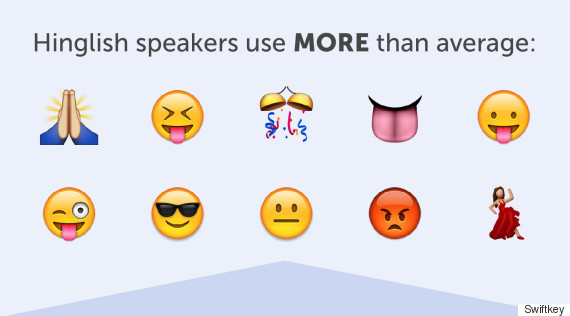
Do you find yourself using these emojis very often?
If so, chances of your belonging to the Hinglish speaking community are pretty high. Earlier this year, SwiftKey analysed over a billion pieces of emoji data to understand how people from different languages used emojis (digital images used to express emotions). Soon after, they launched a second report that recorded 15 new languages (additional 500,000 pieces of data), including an analysis of emoji use amongst Hinglish speakers.
This study was inspired by the increased usage of emojis for expression across the world. “Emoji are spread by word of mouth, or in this case word of keyboard," said Catalina Hallett, language engineer at SwiftKey. "They tend to spread within groups of users that come into verbal contact first – so a group of friends and their social network, then the wider network or country." Hallet added that since emojis are language-dependent, she suspects the use of certain emojis will spread much more quickly than language slang and cross country boundaries much more easily.
The study that was based on the language installed on users' devices found that the above given emojis were the most likely to be used: The data said that Hinglish speakers like to celebrate, read, and pray (this emoji was used four times more than any other, however does not rank highly as it only makes up 0.8% of Hinglish speakers use of all emojis).

It also showed Hinglish users often communicate about farm animals (errr...)

Another analytical reading showed that Hinglish speakers were more likely to employ party emojis (anything from the cake emoji to balloons and party streamers) than any other language, rendering them the 'undisputed party animals of emoji' according to the study.

Swiftkey's initial study showed French emoji users used the heart more often than anyone else. Interesting French was the only language where the smiley emoticon was not number 1 - several Eastern European and Scandinavian led with the smiley emoji instead. Australia led both junk food and holiday emoji usage, while American users led the rankings for a random employment of emojis. The second report showed Sweden (famed for its crisp, soft and sweet breads) used the bread icon more than anyone else, while Finnish speakers used the black moon emoji more than any other language (a nod to their long winter nights, the study suggested).
Swiftkey's research also found that these were the emojis least likely to be used by Hinglish users. Surprisingly, this included the popular heart-shaped emoji - in fact Hinglish users ranked bottom across all languages for this particular icon:

The study from Swiftkey Cloud was conducted after a four-month analysis (October 2014 to January 2015), across both Android and Apple's IOS platforms.
Here's a summary of the report for Hinglish users:

 Like Us On Facebook |
Like Us On Facebook |  Follow Us On Twitter |
Follow Us On Twitter |